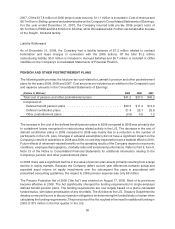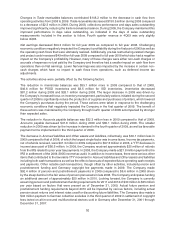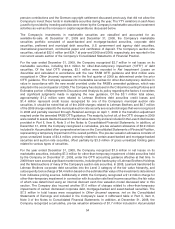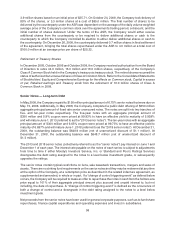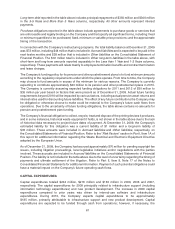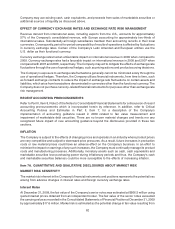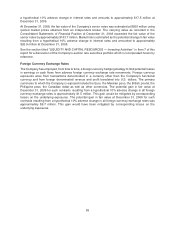Lexmark 2009 Annual Report Download - page 66
Download and view the complete annual report
Please find page 66 of the 2009 Lexmark annual report below. You can navigate through the pages in the report by either clicking on the pages listed below, or by using the keyword search tool below to find specific information within the annual report.
was extended to October 1, 2010. There were no secured borrowings outstanding under the trade
receivables facility at December 31, 2009 or December 31, 2008.
This facility contains customary affirmative and negative covenants as well as specific provisions related to
the quality of the accounts receivables transferred. As collections reduce previously transferred
receivables, the Company may replenish these with new receivables. Lexmark bears a limited risk of
bad debt losses on the trade receivables transferred, since the Company over-collateralizes the
receivables transferred with additional eligible receivables. Lexmark addresses this risk of loss in its
allowance for doubtful accounts. Receivables transferred to the unrelated third-party may not include
amounts over 90 days past due or concentrations over certain limits with any one customer. The facility
also contains customary cash control triggering events which, if triggered, could adversely affect the
Company’s liquidity and/or its ability to obtain secured borrowings. A downgrade in the Company’s credit
rating would reduce the amount of secured borrowings available under the facility.
Other Information
The Company’s credit rating was downgraded by Standard & Poor’s Ratings Services during the first
quarter of 2009 from BBB to BBB-. On April 28, 2009, Moody’s Investors Services downgraded the
Company’s current credit rating from Baa2 to Baa3. Because the ratings remain investment grade, there
were no material changes to the borrowing capacity or cost of borrowing under the facilities that existed at
that time, nor were there any adverse changes to the coupon payments on the Company’s public debt. The
Company does not have any rating downgrade triggers that accelerate the maturity dates of its revolving
credit facility or public debt.
The Company’s credit rating can be influenced by a number of factors, including overall economic
conditions, demand for the Company’s printers and associated supplies and ability to generate
sufficient cash flow to service the Company’s debt. A downgrade in the Company’s credit rating to
non-investment grade would decrease the maximum availability under its trade receivables facility,
increase the cost of borrowing under the revolving credit facility and the coupon payments on the
Company’s public debt, potentially trigger collateral requirements under the new revolving credit facility
described above, and likely have an adverse effect on the Company’s ability to obtain access to new
financings in the future.
The Company is in compliance with all covenants and other requirements set forth in its debt agreements.
Off-Balance Sheet Arrangements
At December 31, 2009 and 2008, the Company did not have any off-balance sheet arrangements.
Contractual Cash Obligations
The following table summarizes the Company’s contractual obligations at December 31, 2009:
(Dollars in Millions) Total
Less than
1 Year
1-3
Years
3-5
Years
More than
5 Years
Long-term debt
(1)
. . . . . . . . . . . . . . . . . . . . . . . . . $ 892 $ 41 $ 81 $400 $370
Operating leases. . . . . . . . . . . . . . . . . . . . . . . . . . 81 30 34 13 4
Purchase obligations . . . . . . . . . . . . . . . . . . . . . . . 131 131 — — —
Uncertain tax positions . . . . . . . . . . . . . . . . . . . . . 33 6 21 6 —
Other long-term liabilities
(2)
................. 91 46 32 — 13
Total contractual obligations . . . . . . . . . . . . . . . . . $1,228 $254 $168 $419 $387
(1) includes interest payments
(2) includes current portion of other long-term liabilities
60


